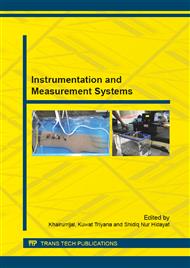p.191
p.195
p.200
p.204
p.209
p.213
p.218
p.223
p.227
Rapid Discrimination of Indonesian Herbal Medicines by Using Electronic Nose Based on Array of Commercial Gas Sensors
Abstract:
The aim of this study is to discriminate herbal medicines (here after referred to as herbals) by an electronic nose (e-nose) based on an array of eight commercially gas sensors and multivariate statistical analyses. Seven kinds of herbal essential oils purchased from local market in Yogyakarta Indonesia, including zingiber officinale (ZO), kaempferia galanga (KG), curcuma longa (CL), curcuma zedoaria (CZ), languas galanga (LG), pogostemon cablin (PO), and curcuma xanthorrizha roxb (CX) were measured by using this e-nose consecutively. Due to the use of dynamic headspace in this e-nose, data for one cycle (sampling and purging) were recorded every five second for 10 cycles. Each kind of herbals was analyzed for five replications and relative amplitude of the responses was extracted as a feature. The statistical analyses of principal component analysis (PCA) and cluster analysis (CA) were used for discriminating samples. The PCA score plot shows that these 35 essential oil samples were separated into 7 groups based on similarity of patterns. The first two components, PC1 and PC2, capture 96.2% of data variance. Meanwhile, by using 80% similarity, the CA clusters 7 herbals into 3 classes. In this case, the first class consists of ZO and CZ and the second class consists of KG, CL, LG and CX, while the PO sample is clustered in the third class. These classes need to be validated using a standard analytical instrument such as GC/MS. The technique shows some advantages including easy in operation because of without any sample preparation, rapid detection, and good repeatability.
Info:
Periodical:
Pages:
209-212
Citation:
Online since:
July 2015
Authors:
Price:
Сopyright:
© 2015 Trans Tech Publications Ltd. All Rights Reserved
Share:
Citation:


